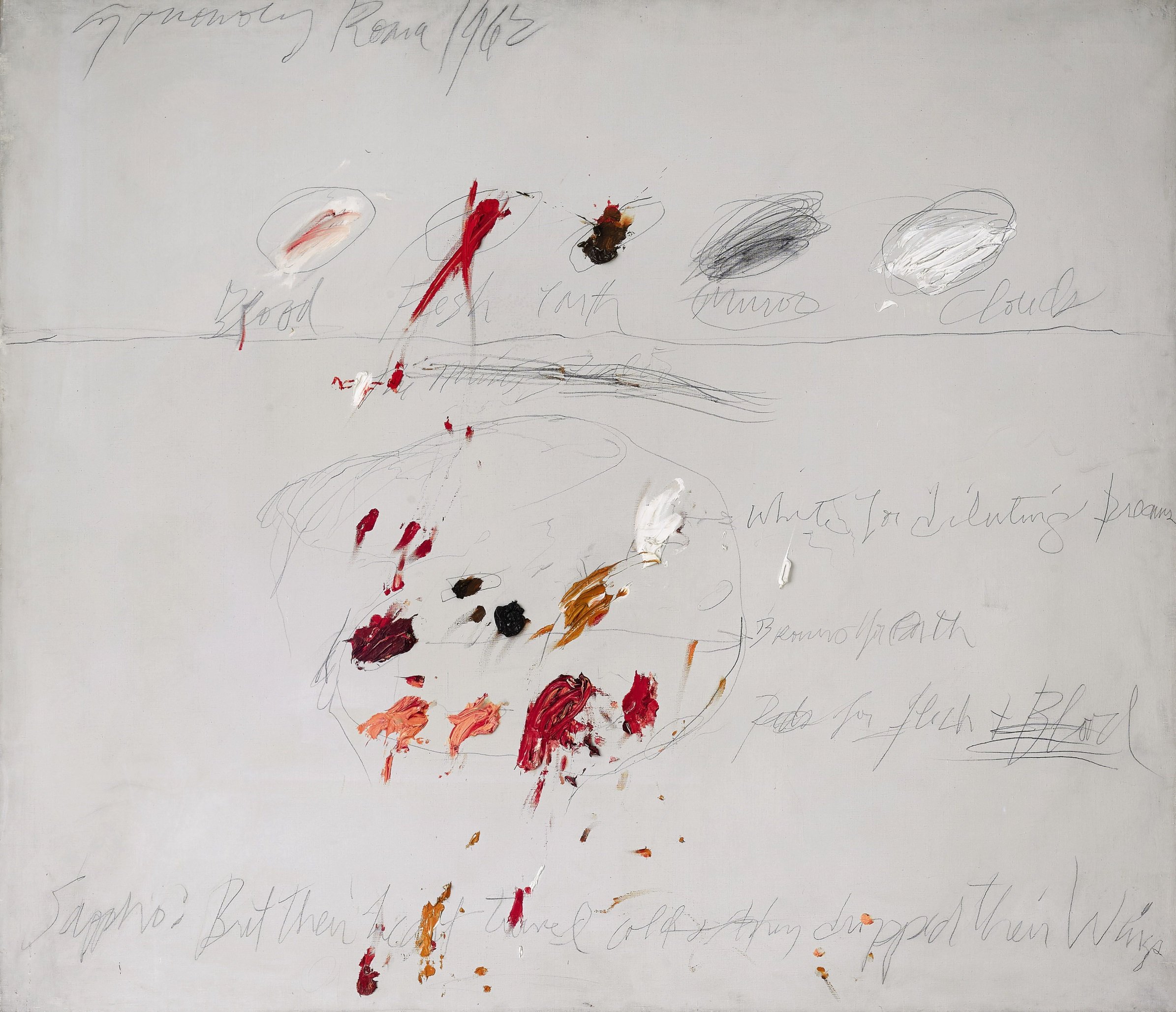
Sotheby’s opened its Frieze week auctions this evening with a £50.3 million sale ($66.5 million) including buyers’ premium—its highest yet for an October contemporary art sale in London. After four lots were withdrawn, the estimate for the 43 lots was £43.6–60.4 million excluding the premium. Last October, the equivalent sale at Sotheby’s made an above-estimate £47.9 million.
It was not always a super-charged evening, however. Five lots, including Jean-Michel Basquiat’s fairly stark portrait Bronze (estimate £5-7 million), went unsold. The Basquiat carried a guarantee from Sotheby’s so can be counted as a loss. The top price was for Cy Twombly’s Untitled, a fluid text work with smeared pigments from 1962, inscribed with the words “Blood, Flesh, Youth, Mirror, Clouds.” It seemed to struggle to find a bid until dealers Nick Acquavella and Ezra Nahmad came forward to ply a phone bidder into paying a within-estimate £6.4 million.
As is now a tradition, the front of the sale was stacked with sure firecrackers. A huge 2010-2012 sea painting by mid-career Belgian artist Thierry de Cordier, exhibited at the Venice Biennale in 2013, carried a £250,000 low estimate, which would have in itself been a record for the artist. The work follows a £68,750 sale, triple its estimate, of a much smaller landscape by de Cordier this summer. “De Cordier doesn’t produce much and is sought after by the best collectors,” a Belgian art advisor told me. Six phone bidders vied for it as it sold for £380,750.
Thierry De Cordier’s Tempete En Mer Du Nord, Etude No. 3 (2010-12). © Sotheby’s.
A second record fell when a vibrantly colored Homage to the Square: Temperate (1957) by Josef Albers sold for £2.3 million ($3 million)—more than double its estimate. The painting had previously sold in 2007 for £445,600. The only other record in the sale was for a recent composition, Bandaids with Butterfly, by Alex da Corte, which sold to London gallerist Carl Kostyal for a double estimate £40,000.
Forty works by the UK-based photographer Wolfgang Tillmans have been offered and sold at auction already this year and another 11 are spread out among the Frieze week auctions. This follows a price hike triggered by the artist’s successive solo shows at Tate and the Beyeler Foundation last year. At a small Christie’s sale for design and photography on Tuesday (where top Basquiat buyer Yusako Maezawa was spotted buying a Jean Prouvé stool) there were signs that the Tillmans market had peaked when a large guaranteed abstract, Urgency XV1 (2006), hammered at £280,000, below the ambitious £300,000 estimate—presumably to the guarantor. However, at Sotheby’s tonight, fears were put to rest as another large unique abstract c-print by Tillmans, Greifbar 26, more attractively estimated at £150,000, sold to an online bidder for £548,750, not far off the artist’s record.
The first major painting at auction by British artist Howard Hodgkin since his death this year (two more are appearing at Christie’s tomorrow evening), House (2005-07), had been acquired at the Red Auction charity sale at Sotheby’s New York in 2008 for a then record $792,000. In the last couple of years, Hodgkin’s record has risen to $1.8 million. Nonetheless, the low estimate was reduced this time around to £350,000 ($450,000)—on the principle, perhaps, that prices at charity sales can be inflated. Notwithstanding, the work sold for £890,750 ($1.2 million)—the second highest price in dollars for the artist.
Howard Hodgkin’s House (2005-07). © Sotheby’s.
Also setting a second-highest record was David Hockney’s 15 Canvas Study of the Grand Canyon (1998), which sold to a US buyer above estimate for £6 million ($8 million).
Four paintings by the rarely sighted Hurvin Anderson, a protégé of Peter Doig, are on offer in the London sales this week, perhaps encouraged by the artist’s nomination for the Turner Prize this year. Sotheby’s had the first example tonight, Untitled (Beach Scene), bought in 2009 for a record £97,250 by Charles Saatchi. Saatchi then sold it four years later for a record £302,500. Since then Anderson’s record has risen to £1.3 million. So tonight’s estimate of £500,000-700,000 didn’t look so greedy in that context, and it rose on the strength of Asian competition to £890,750—a handsome return for the consignor.
Hurvin Anderson’s Untitled (Beach Scene) (2003). © Sotheby’s.
The sale was marked by comparatively few guarantees—just nine works with a combined low estimate of £11.7 million—and they rarely paid off for the guarantors. Third-party guarantors appeared to end up with two spin paintings by Damien Hirst and Basquiat’s Remote Commander (1984) when there was no other bidding, but another guarantor did well from the upside on Antony Gormley’s Sublimate V1,which doubled its estimate to sell for £758,750.
Sotheby’s did not do so well. A guarantee on Andreas Gursky’s Stateville Illinois appeared to be coming adrift until it was rescued by Gagosian Gallery, which paid a below estimate £308,750 for it. And on top of the loss of the Basquiat, they also guaranteed Gursky’s Bahrain 11, with a £550,000 low estimate that failed to sell.
Among the few other buyers in the packed room were dealers Ezra Nahmad, who bought Richard Prince’s car hood Point Courage (1988-89) within its estimate, for £1.5 million, and Mickey Tiroche who worked hard to secure an untitled papier-mâché sculpture by Franz West for a top estimate £308,750.
In an evening of fluctuating bidding, the bargain must have been Andy Warhol’s 5 Deaths, which sold for £968,750 against a £2million estimate.
Andy Warhol’s 5 Deaths (1963). © Sotheby’s.
Tomorrow, having abandoned its June sale this year, Christie’s stages its main post-war and contemporary art sale with a low estimate of £143.5 million, potentially dwarfing Sotheby’s sale tonight. Alex Branczik of Sotheby’s remains resolute in maintaining its own summer sale, however. “Our strategy is to continue to offer clients a platform to buy and sell throughout the year,” which means including London in summer, and maintaining what he describes as “the ecosystem of the market.”